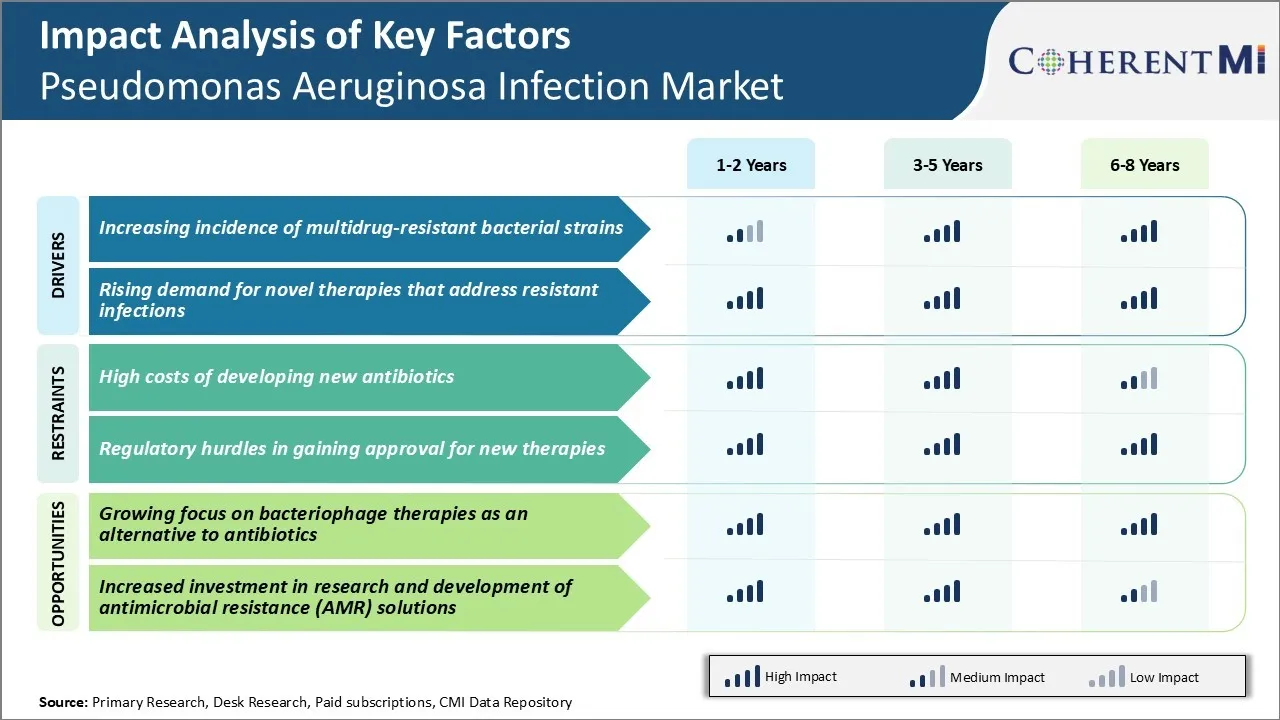Pseudomonas Aeruginosa Infektionsmarkt GRÖSSEN- UND MARKTANTEILSANALYSE - WACHSTUMSTRENDS UND PROGNOSEN (2024 - 2031)
Pseudomonas Aeruginosa Infection Market wird von Drug (Monoclonal Antibody, Small Molecule, Peptide), By Route of Administration (Oral, Parenteral, To....
Pseudomonas Aeruginosa Infektionsmarkt Trends
Markttreiber - zunehmende Inzidenz von multidrug-resistenten Bacterial Strains
Pseudomonas aeruginosa gilt als berüchtigter Fehler aufgrund seiner intrinsischen Widerstandsfähigkeit, die es erlaubt, einer Vielzahl von antimikrobiellen Mitteln zu widerstehen. Die steigende Prävalenz von multidrug-resistenten Pseudomonas aeruginosa-Infektionen stellt sowohl im Gesundheitswesen als auch in der Gemeinschaft eine erhebliche Bedrohung dar. Behandlungsversagen und Mortalität, die mit solchen Infektionen verbunden sind, haben zugenommen. Multidrug-resistente Stämme verbreiteten sich schnell zwischen Patienten vor allem in überfüllten Gesundheitseinrichtungen mit schlechten Infektionskontrollpraktiken.
Ausbrüche aufgrund dieser "Superbugs" haben sich über Geographien verbreitet. Darüber hinaus ermöglicht die Biofilmbildung auf indwelling medizinischen Geräten, dass die Bakterien länger andauern, was zu chronisch resistenten Infektionen führt, die schwerer zu löschen sind.
Die wachsende Resistenz unterstreicht den dringenden Bedarf an neuartigen Medikamenten, die gegen Frontal-Antimikrobielle resistente Stämme effektiv bekämpfen können. Traditionelle Drogenentdeckungsansätze müssen mit neueren Strategien ergänzt werden, die darauf ausgerichtet sind, bakterielle Virulenz zu modulieren, Biofilmbildung zu hemmen und Abflussmechanismen zu stören.
Kombinationstherapien sowie alternative Behandlungsmethoden, wie z.B. die Phagentherapie, versprechen auch bei Überwindung der Resistenz. Insgesamt hat die Pervasivität multidrug-resistenter Pseudomonas aeruginosa Stämme den klinischen Imperativ für effektivere Therapien erhöht und damit das Wachstum in diesem Markt vorangetrieben.
Markttreiber - steigende Nachfrage nach neuartigen Therapien, die reaktionsschnelle Infektionen ansprechen
Die Unfähigkeit, multidrug-resistente Pseudomonas aeruginosa Infektionen mit bestehenden antimikrobiellen Armamentarium effektiv zu behandeln, hat zu einer erhöhten Nachfrage nach neueren Behandlungsparadigmen geführt. Herkömmliche Antibiotika scheitern gegen diese "Superbugs" und die abnehmende Drogenpipeline fordert innovative nicht-antibiotische Therapien, die Resistenz ansprechen können. Darüber hinaus besteht die Notwendigkeit, neue Medikamente zu entwickeln, die gezielt auf Pseudomonas aeruginosa abzielen können, ohne sich mit kreuzweisenden Problemen auseinanderzusetzen.
Traditionelle Kleinmolekülantibiotika beweisen inmitten kontinuierlich wachsender Widerstandsmechanismen zunehmend ineffizient. Neuartige therapeutische Ansätze wie monoklonale Antikörper, Antivirulenzmedikamente, biofilmdisrupting agenten und phage therapien haben in letzter Zeit ein erhebliches Forschungsinteresse. Diese alternativen Modalitäten zielen darauf ab, bakterielle Pathogenese durch nicht-antibiotische Mechanismen zu drosseln, wodurch das Auftreten von Widerstand verlangsamt wird.
Immuntherapien, die die natürlichen Abwehrkräfte des Körpers nutzen, werden ebenfalls erforscht. Monoklonale Antikörper stellen einen attraktiven Immuntherapieansatz dar, der den Schutz gegen virulente Stämme ermöglicht. Agenten, die kritische Virulenzfaktoren von Pseudomonas aeruginosa wie Typ III Sekretionssystem und damit verbundene Giftstoffe ansprechen, halten Versprechen.
Darüber hinaus zeigen Kombinationsregime, die Synergien zwischen Drogenklassen nutzen, die Fähigkeit, antimikrobielle Aktivität gegen resistente Stämme wiederherzustellen. Alternative Therapien mit Phage-Endolysinen, Bakteriophagentherapie und entwickelter Synergie erzeugen Optimismus.

Markt Challenge - Hohe Kosten für die Entwicklung neuer Antibiotika
Eine der großen Herausforderungen, denen der Infektionsmarkt Pseudomonas aeruginosa ausgesetzt ist, sind die extrem hohen Kosten, die mit der Entwicklung neuer Antibiotika verbunden sind. Die Entwicklung eines brandneuen Antibiotikums kann aufgrund des langen Forschungs- und klinischen Studienprozesses, der für die FDA-Zulassung erforderlich ist, über $1 Milliarden USD kosten.
Aufgrund dieser hohen Kosten haben Pharmaunternehmen wenig Anreiz, in die Entwicklung von Behandlungen für multidrug-resistente Erreger wie P. aeruginosa zu investieren, die typischerweise kleinere Patientenpopulationen haben. Zusätzlich, sobald ein neues Antibiotikum genehmigt wird, gibt es Befestigungsdrücke, um seine Verwendung als "letztes Resort" Option zu reservieren, seine potenziellen Umsatzerlöse im Vergleich zu breiteren Antibiotika begrenzen.
Diese kombinierten Faktoren von hohen Entwicklungskosten und kleineren Marktgrößen bedeuten, dass neue Antibiotika-Forschungs- und Zulassungsquoten in den letzten Jahren deutlich zurückgegangen sind, so dass wenige Behandlungsinnovationen in der Pipeline für ernsthafte Gram-negative Infektionen wie P. aeruginosa.
Es sei denn, regulatorische Anreize oder öffentlich-private Partnerschaften können dazu beitragen, diese finanziellen Barrieren zu kompensieren, können drogenbeständige Bedrohungen wie P. aeruginosa unsere vorhandenen Antibiotika schneller überholt werden als Ersatz.
Marktchance - Fokus auf Bacteriophage Therapien als Alternative zur Antibiotika
Eine vielversprechende Gelegenheit im Pseudomonas aeruginosa Infektionsmarkt ist der wachsende Fokus auf die Entwicklung von Bakteriophagentherapien als Alternative zu traditionellen Antibiotika. Bakteriophagen sind Viren, die gezielt bestimmte Bakterienstämme anvisieren und töten, ohne menschliche Zellen zu verletzen.
Durch ihre Fähigkeit, sich selbst zu vermehren, können Phagetherapien viele der Herausforderungen, denen neue Antibiotika-Entwicklung ausgesetzt sind, umgehen, indem sie die damit verbundenen Forschungs- und Herstellungskosten erheblich senken. Mehrere Biotech- und Pharmaunternehmen führen jetzt klinische Studien über Phagetherapien für schwer zu behandelnde Infektionen wie P. aeruginosa durch, die durch ihr Potenzial als lebende Medikamente anpassbar für verschiedene antibiotika-resistente Stämme gefördert werden.
Da mehr Beweise für ihre Sicherheit und Wirksamkeit im Vergleich zu Antibiotika entstehen, könnten Phagetherapien neue Behandlungsoptionen für P. aeruginosa und andere multidrug-resistente Erreger eröffnen. Ihre Fähigkeit, sich selbst zu bewegen, verringert auch den selektiven Druck, der weitere Bakterienresistenz treiben. Wenn die laufende Forschung weiterhin ihre Versprechen bestätigt, können Bakteriophagentherapien einen Durchbruch in unserer anhaltenden Schlacht gegen Antibiotikaresistenz darstellen.